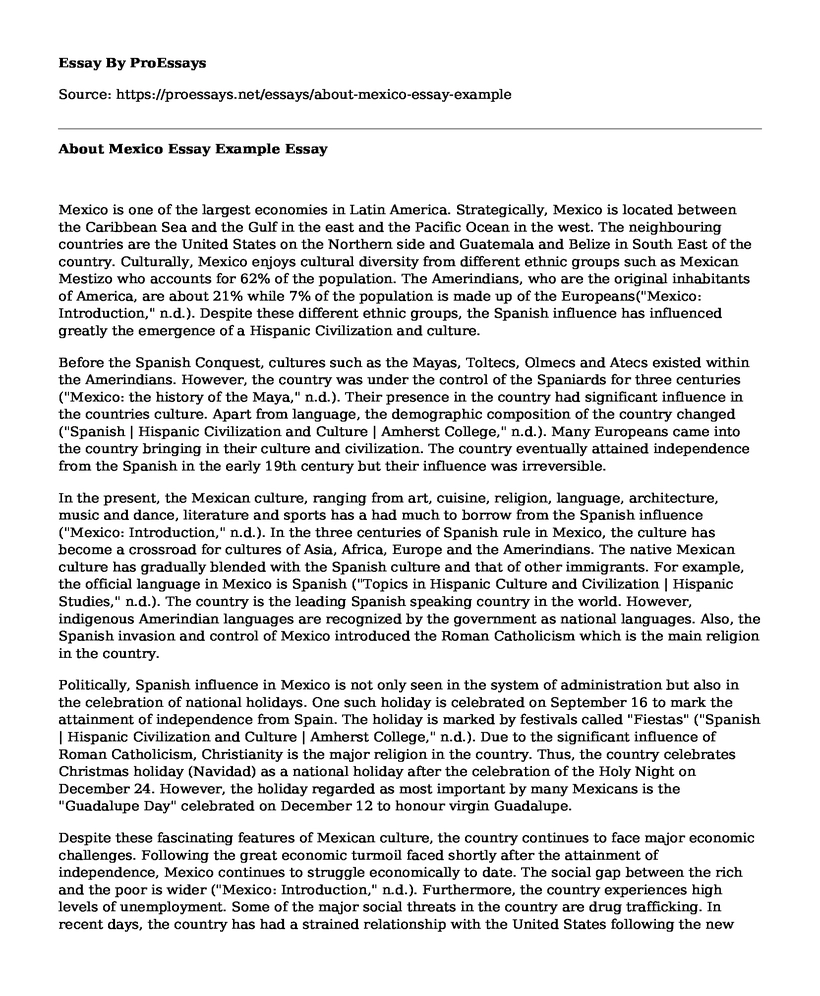Mexico is one of the largest economies in Latin America. Strategically, Mexico is located between the Caribbean Sea and the Gulf in the east and the Pacific Ocean in the west. The neighbouring countries are the United States on the Northern side and Guatemala and Belize in South East of the country. Culturally, Mexico enjoys cultural diversity from different ethnic groups such as Mexican Mestizo who accounts for 62% of the population. The Amerindians, who are the original inhabitants of America, are about 21% while 7% of the population is made up of the Europeans("Mexico: Introduction," n.d.). Despite these different ethnic groups, the Spanish influence has influenced greatly the emergence of a Hispanic Civilization and culture.
Before the Spanish Conquest, cultures such as the Mayas, Toltecs, Olmecs and Atecs existed within the Amerindians. However, the country was under the control of the Spaniards for three centuries ("Mexico: the history of the Maya," n.d.). Their presence in the country had significant influence in the countries culture. Apart from language, the demographic composition of the country changed ("Spanish | Hispanic Civilization and Culture | Amherst College," n.d.). Many Europeans came into the country bringing in their culture and civilization. The country eventually attained independence from the Spanish in the early 19th century but their influence was irreversible.
In the present, the Mexican culture, ranging from art, cuisine, religion, language, architecture, music and dance, literature and sports has a had much to borrow from the Spanish influence ("Mexico: Introduction," n.d.). In the three centuries of Spanish rule in Mexico, the culture has become a crossroad for cultures of Asia, Africa, Europe and the Amerindians. The native Mexican culture has gradually blended with the Spanish culture and that of other immigrants. For example, the official language in Mexico is Spanish ("Topics in Hispanic Culture and Civilization | Hispanic Studies," n.d.). The country is the leading Spanish speaking country in the world. However, indigenous Amerindian languages are recognized by the government as national languages. Also, the Spanish invasion and control of Mexico introduced the Roman Catholicism which is the main religion in the country.
Politically, Spanish influence in Mexico is not only seen in the system of administration but also in the celebration of national holidays. One such holiday is celebrated on September 16 to mark the attainment of independence from Spain. The holiday is marked by festivals called "Fiestas" ("Spanish | Hispanic Civilization and Culture | Amherst College," n.d.). Due to the significant influence of Roman Catholicism, Christianity is the major religion in the country. Thus, the country celebrates Christmas holiday (Navidad) as a national holiday after the celebration of the Holy Night on December 24. However, the holiday regarded as most important by many Mexicans is the "Guadalupe Day" celebrated on December 12 to honour virgin Guadalupe.
Despite these fascinating features of Mexican culture, the country continues to face major economic challenges. Following the great economic turmoil faced shortly after the attainment of independence, Mexico continues to struggle economically to date. The social gap between the rich and the poor is wider ("Mexico: Introduction," n.d.). Furthermore, the country experiences high levels of unemployment. Some of the major social threats in the country are drug trafficking. In recent days, the country has had a strained relationship with the United States following the new Boarder policies by the government.
Conclusion
In conclusion, Mexico is a country that is marked by the great influence of the Spanish and immigrant cultures. The Spanish conquest and rule for over three centuries changed the culture in many ways. The Spanish language is highly used in Mexico than in any other country in the world. Also, other aspects of the countries cultural heritage such as the celebration of national holidays are highly influenced by the Spaniards.
References
Mexico: Introduction. (n.d.). Retrieved from https://globaledge.msu.edu/countries/mexico Accessed on November 13, 2018.
Mexico: the history of the Maya. (n.d.). Retrieved from https://www.saga.co.uk/magazine/travel/destinations/north-america/mexico/mexico-the-history-of-the-maya Accessed on November 13, 2018.
Spanish | Hispanic Civilization and Culture | Amherst College. (n.d.). Retrieved from https://www.amherst.edu/academiclife/departments/courses/0708S/SPAN/SPAN-08-0708S Accessed on November 13, 2018.
Topics in Hispanic Culture and Civilization | Hispanic Studies. (n.d.). Retrieved from https://www.brown.edu/academics/hispanic-studies/courses/detail?term=201710&crn=16668 Accessed on November 13, 2018.
Cite this page
About Mexico Essay Example. (2022, Oct 03). Retrieved from https://proessays.net/essays/about-mexico-essay-example
If you are the original author of this essay and no longer wish to have it published on the ProEssays website, please click below to request its removal:
- Food Additives and Health Concerns in America Essay
- Research Paper on Container Deposit Laws
- Issues Relating to Foreign Business Operations in South Africa Essay Example
- Essay Example on God Bless the Child: US Response to Juvenile Prostitution
- Essay Example on Louisiana: A Rich Tapestry of Cultures & Traditions
- Free Report Example on Improving Living Standards Through Adequate Housing
- Kerner Commission: Addressing Racism - Essay Sample







